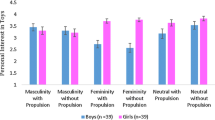Abstract
Androgyny as a sex-role type has been studied extensively in adults but hardly at all in children. In the present study, children in Kindergarten through Grade 2 were administered a sex-role preference test in such a way that masculine and feminine scores could be derived independently. As a test of concurrent validity, the children's masculine and feminine preference scores were correlated with a parent-report measure of sex-typing. Both the child and parent measures showed strong sex differences in the types of stimuli preferred. Significant correlations were found between the parent and child measures for girls, but not for boys. Based on their masculine and feminine scores, children were classified as androgynous, masculine, feminine, or undifferentiated. The "absolute midpoint" method of sex-role classification placed the majority of boys in the masculine category (83%) and the majority of girls in the feminine category (79%); 9% of the boys and 18% of the girls were classified as androgynous. This method of classification yielded results similar to the more commonly used "between-sex" median split procedure, but differed sharply from the "within-sex" median split method, which yielded a more even distribution of children across the four sex-role types. The results were discussed with respect to a number of methodological issues in the measurement of androgyny in children.
Similar content being viewed by others
References
Alpert-Gillis, L.J., & Connell, J.P. (1989). Gender and sex-role influences on children's self-esteem.Journal of Personality, 57, 97–114.
Barenboim, C. (1981). The development of person perception from childhood to adolescence: from behavioral comparisons to psychological constructs to psychological comparisons.Child Development, 52, 129–144.
Baumrind, D. (1982). Are androgynous individuals more effective persons and parents?Child Development, 53, 44–75.
Bem, S.L. (1974). The measurement of psychological androgyny.Journal of Consulting and Clinical Psychology, 42, 155–162.
Bem, S.L. (1983). Gender schema theory and its implications for child development: raising gender-aschematic children in a gender-schematic society.Signs, 8, 598–616.
Chasen, B. (1977). Toward eliminating sex-role stereotyping in early childhood classes.Child Care Quarterly, 6, 30–41.
Constantinople, A. (1973). Masculinity-feminity: an exception to a famous dictum?Psychological Bulletin, 80, 389–407.
Elizabeth, P.H., & Green, R. (1984). Childhood sex-role behaviors: similarities and differences in twins.Acta Geneticae Medicae et Gemellologiae, 33, 173–179.
Elizabeth, P.H., Meyer-Bahlburg, H.F.L., Janal, M.N., Ehrhardt, A.A., & Green, R. (1984). Do human twins show a "free-martin" like phenomenon? Paper presented at the meeting of the International Academy of Sex Research, Cambridge England.
Emilhovich, C.A., & Gaier, E.L. (1983). Women's liberation and pre-adolescent sex role stereotypes.Adolescence, 18, 637–647.
Fagot, B.I. (1978). The consequences of same-sex, cross-sex, and androgynous preferences. Paper presented at the meeting of the Western Psychological Association, San Francisco, CA.
Flake-Hobson, C., Skeen, P., & Robinson, B.E. (1980). Review of theories and research concerning sex-role development and androgyny with suggestions for teachers.Family Relations, 29, 155–162.
Gilbert, L.A. (1984). Unnecessary worry and concern. [Review of girls and boys: the limits of nonsexist child rearing].Contemporary Psychology, 29, 725–726.
Hall, J.A., & Halberstadt, A.G. (1980). Masculinity and femininity in children: development of the Children's Personal Attributes Questionnaire.Developmental Psychology, 16, 270–280.
Huston, A.C. (1985). The development of sex typing: themes from recent research.Developmental Review, 5, 1–17.
Huston, A.C., Carpenter, C.J., Atwater, A.B., & Johnson, L.M. (1986). Gender, adult structuring of activities, and social behavior in middle childhood.Child Development, 57, 1200–1209.
Katz, P.A. (1986). Modification of children's gender-stereotyped behavior: general issues and research considerations.Sex Roles, 14, 591–602.
Kirk, R.E. (1968).Experimental design: procedures for the behavioral sciences. Belmont, CA: Brooks/Cole.
Kramer, C.Y. (1956). Extension of multiple range tests to group means with unequal numbers of replications.Biometrics, 12, 307–310.
Kurdek, L.A., & Stiesky, A.E. (1980). Sex role self-concepts of single divorced parents and their children.Journal of Divorce, 3, 249–261.
Massad, C.M., Patterson, C.J., & O'Brien, R.G. (1980). Sex-role identity and peer acceptance during childhood. Unpublished manuscript, Indiana University.
Moore, S.M. (1985). The Children's Sex-Role Test.Psychological Reports, 57, 586.
Nunnally, J.C. (1978).Psychometric theory (second ed.). New York: McGraw-Hill.
Oleshansky, B.A. (1981). Measuring children's gender: the androgyny perspective. Unpublished doctoral dissertation, University of Michigan.
Rholes, W.S., & Ruble, D.N. (1984). Children's understanding of dispositional characteristics of others.Child Development, 55, 550–560.
Robinson, B.E., & Green, M.G. (1981). Beyond androgyny: the emergence of sex-role transcendence as a theoretical construct.Developmental Review, 1, 247–265.
Schau, C.G., Kahn, L., Diepold, J.H., & Cherry, F. (1980). The relationships of parental expectations and preschool children's verbal sex typing to their sex-typed toy play behavior.Child Development, 51, 266–270.
Simms, R.E., Davis, M.H., Foushee, H.C., Holahan, C.K., Spence, J.T., & Helmreich, R.L. (1978). Psychological masculinity and feminity in children and their relationships to trait stereotypes and toy preference. Paper presented at the meeting of Southwestern Psychological Association, New Orleans, LA.
Statham, J. (1986).Daughters and sons: experiences of non-sexist child raising. New York: Basil Blackwell.
Stericker, A.B., & Kurdek, L.A. (1982). Dimensions and correlates of third through eighth graders' sex-role self-concepts.Sex Roles, 8, 915–929.
Wolf, R.N. (1980). The development of a non-verbal scale measure of androgyny. Unpublished doctoral dissertation, St. John's University, Jamaica, New York.
Zucker, K.J. (1977). Sex-typing of children's toys by college students and fourth graders.Catalogue of Selected Documents in Psychology, 7, 6–7.
Author information
Authors and Affiliations
Rights and permissions
About this article
Cite this article
Zucker, K.J., Torkos, H. Assessment of androgyny in children. Annals of Sex Research 2, 187–203 (1989). https://doi.org/10.1007/BF00849715
Issue Date:
DOI: https://doi.org/10.1007/BF00849715



